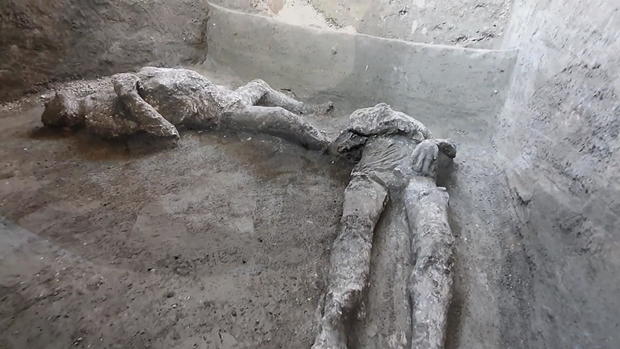
New DNA evidence at Pompeii reveals surprises about identities of Vesuvius eruption victims
When a volcanic eruption buried the ancient city of Pompeii, the last desperate moments of its citizens were preserved in stone for centuries.
Observers see stories in the plaster casts later made of their bodies, like a mother holding a child and two women embracing as they die.
But new DNA evidence suggests things were not as they seem — and these prevailing interpretations come from looking at the ancient world through modern eyes.
published Thursday in the journal Current Biology.
CBS News
The team, which also includes scientists from Harvard University and the University of Florence in Italy, relied on genetic material preserved for nearly two millennia. After Mount Vesuvius erupted and destroyed the Roman city in 79 A.D., bodies buried in mud and ash eventually decomposed, leaving spaces where they used to be. Casts were created from the voids in the late 1800s.
Researchers focused on 14 casts undergoing restoration, extracting DNA from the fragmented skeletal remains that mixed with them. They hoped to determine the sex, ancestry and genetic relationships between the victims.
There were several surprises in “the house of the golden bracelet,” the dwelling where the assumed mother and child were found. The adult wore an intricate piece of jewelry, for which the house was named, reinforcing the impression that the victim was a woman. Nearby were the bodies of another adult and child thought to be the rest of their nuclear family.
DNA evidence showed the four were male and not related to one another, clearly showing “the story that was long spun around these individuals” was wrong, Mittnik said.
Researchers also confirmed Pompeii citizens came from diverse backgrounds but mainly descended from eastern Mediterranean immigrants – underscoring a broad pattern of movement and cultural exchange in the Roman Empire. Pompeii is located about 150 miles (241 kilometers) from Rome.
The study builds upon research from 2022 when scientists sequenced the genome of a Pompeii victim for the first time and confirmed the possibility of retrieving ancient DNA from the human remains that still exist.
“They have a better overview of what’s happening in Pompeii because they analyzed different samples,” said Gabriele Scorrano of the University of Rome Tor Vergata, a co-author of that research who was not involved in the current study. “We actually had one genome, one sample, one shot.”
Though much remains to be learned, Scorrano said, such genetic brushstrokes are slowly painting a truer picture of how people lived in the distant past.
In August, archaeologists at Pompeii announced they had unearthed the remains of two more victims — a man and a woman discovered inside what was likely the bedroom of their home, where they’d become trapped as the rest of the structure filled with debris. The woman was found on the bed with a collection of gold, silver and bronze coins, as well as a pair of gold earrings, a pair of pearl earrings and other jewelry.
Earlier this year, three researchers won a $700,000 prize for using artificial intelligence to read a 2,000-year-old scroll that was scorched in the Vesuvius eruption.
The Herculaneum papyri consist of about 800 rolled-up Greek scrolls that were carbonized during the 79 CE volcanic eruption that buried the ancient Roman town, according to the organizers of the “Vesuvius Challenge.”
The scroll’s author was “probably Epicurean philosopher Philodemus,” writing “about music, food, and how to enjoy life’s pleasures,” wrote contest organizer Nat Friedman on social media.
The scrolls were found in a villa thought to be previously owned by Julius Caesar’s patrician father-in-law, whose mostly unexcavated property held a library that could contain thousands more manuscripts.
Source: cbsnews.com